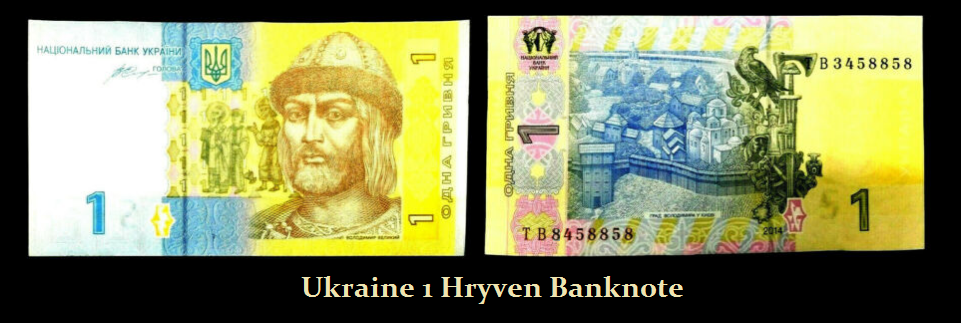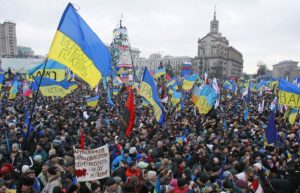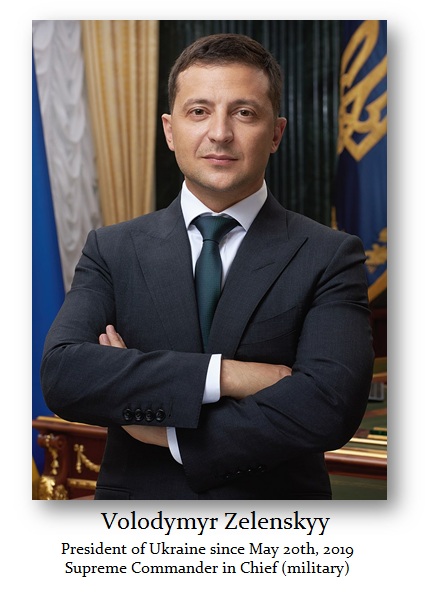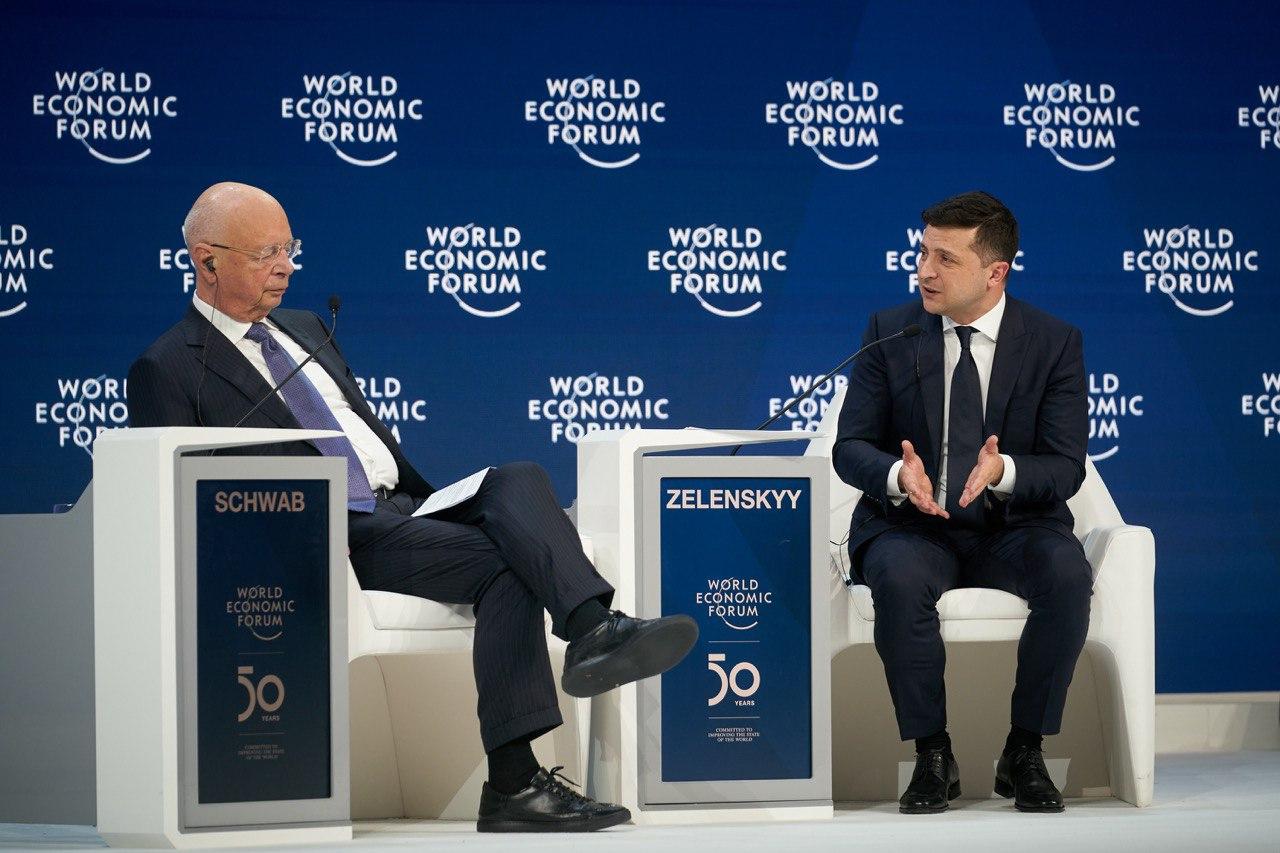About 1500 BC nomadic tribes appeared on the territory of Ukraine. One of them was the Cimmerians (9th-8th–century BC), which are mentioned in written sources. Scythians, Iranian-speaking people from Central Asia, in the 7th century BC pushed the Cimmerians from the Ukrainian steppes. Around the same period, the Greeks began to establish the first colonies in the Northern Black Sea region. Scythians created the first centralized state in Ukraine when they displaced Sarmatians about 200BC. This eventually became the Bosporan Kingdom.
The monetary history of Ukraine extends back to ancient times. In fact, it was first colonized by the Greeks. From the 7th century BC, the Greeks began to colonize the coast of the Black Sea. They traded wine, oil, and textiles, silver and gold wares, and clay utensils with local tribes for grain and hides. However, the Greeks also engaged in the slave trade with the locals. Nonetheless, the Greeks introduced their culture to the region bringing civilization to Ukraine. Many local tribes began to adopt Greek customs and religion, as well as their language. The Greek historian Herodotus (c. 484-425 BC) documented information about Ukraine during this early period.
Some of the tribes of Ukraine tended to be nomadic and were moving also in the region of Romania. Others were agricultural and fixed to a location. There appears to be frequent warfare between many tribes that were driven simply by taking the property of others.
The actual oldest known main inhabitants of Ukraine were Cimmerians, from which we derive the name Crimea in the Southern region of Ukraine on the Black Sea. They were replaced during the 5th century BC by Scythians, who appear to have ruled this region until the 2nd century BC. They are famous for producing bronze coinage with the facing Gorgon and coins in the shape of a dolphin. Their region became known as Olbia.
The origin of the Scythians, who produced some remarkable coins, was shrouded in mystery. Herodotus suggested they might have arrived from the northern steppes to displace the Cimmerians, but he also records that they may have been descended from Zeus and the daughter of the Borysthenes river, or originated from the union of Heracles and a half-woman, half-snake who lived in the woodlands.

There were a few Greek outposts in the Tauric Chersonesus, with the foremost being Panticapaeum (‘the garden of Pan’), where this gold stater was produced. It was founded in about 600 B.C. by colonists from Miletus (a Greek city in Turkey) who hoped to gain access to the raw materials and agricultural wealth that flowed through the
Crimea. The region became an important source of grain, gold, and other trade goods, and was an active marketplace for art objects of Greek manufacture, which often are found there.
The artistry of Scythian coins is distinctive because it combines the traditions of nomadic, Greek, and Near-Eastern cultures. It is imbued with a vitality and fierceness quite unlike Classical and early Hellenistic Greek art, which had abandoned Archaic vigor in favor of idealized beauty. The griffin appears on other forms of Scythian art, which often are found in royal tombs.
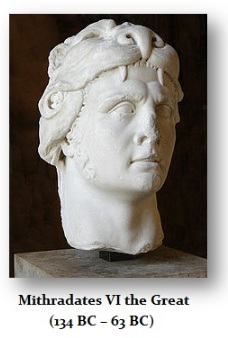 The Scythians were replaced during the 2nd century BC by the Sarmatian tribes, who dominated the region for about 300 years until they were replaced during the 1st century AD by the invading horde known as the Alanis who were primarily Iranian in origin.
The Scythians were replaced during the 2nd century BC by the Sarmatian tribes, who dominated the region for about 300 years until they were replaced during the 1st century AD by the invading horde known as the Alanis who were primarily Iranian in origin.
The northern black sea underwent what some historians refer to as a “long Hellenistic Age” due to the institutions typically associated with the era occurring independently from the greater Greek world. Their relatively isolated position, and constant contact/conflict with barbarians along their borders, allowed monarchs with traditions rooted in the region to establish independent kingdoms from those of the successor states.
Mithridates VI was the ruler of the Kingdom of Pontus in northern Anatolia from 120 to 63 BC, was indeed one of the Roman Republic’s most formidable and determined opponents. He was consumed with his hatred of the Romans that instead of trying to reach a compromise, he assumed he could defeat Rome perhaps as the back-bench is telling Zelensky he can defeat Russia. Following the defeat of Mithridates VI by Pompey, he fled to the northern Black seashores of Crimea where he made plans to raise yet another army to take on the Romans. His eldest living son, Machares, was unwilling to aid his father, so Mithridates had Machares killed. Mithridates then ordered the conscriptions and preparations for war. Then in 63BC, Pharnaces, the youngest son of Mithridates, led a rebellion against his father, joined by Roman exiles. Mithridates VI withdrew to the citadel in Panticapaeum, where he committed suicide. So, the Ukraine region has an interesting history indeed.
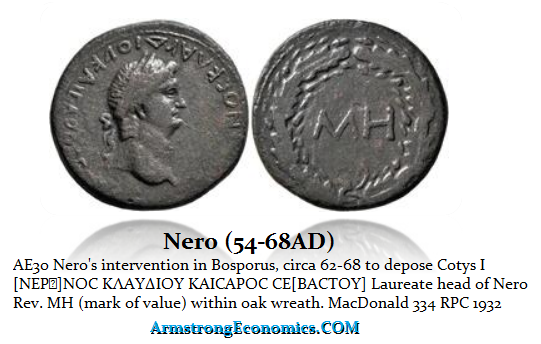
The Bosporan Kingdom of Aspurgus was a client state of the Roman Empire, protected by Roman garrisons. Aspurgus (8BC–38AD) founded a dynasty of kings which endured with a couple of interruptions until 341 AD. Interestingly, during 62AD, for reasons still unknown, Roman emperor Nero deposed the Bosporan king Cotys I over some dispute. Perhaps Nero simply wanted to extend the Roman Empire officially to its furthest East position since Claudius conquered Britain. The Bosporan Kingdom was incorporated as part of the Roman province of Moesia Inferior from 63 to 68AD. With the civil war following Nero’s death, the temporary Roman emperor Galba (68-69AD) restored the Bosporan Kingdom to Rhescuporis I, the son of Cotys I most likely to gain support since he was fighting against other Roman Generals claiming the throne such as Clodius Macer (68AD), Otho (69AD), Vitellius (69AD), and the ultimate victor Vespasian (69-79AD). Thereafter there are gold coins with the Bosporian king and the Roman Emperor confirming it was an independent client-state.
The region was then conquered during the 2nd century AD by the fierce German tribe known as the Goths from the Baltic region who also tormented the Romans. About 370 AD, the first Asian horde of Huns invaded on their way to western Europe. The Huns defeated the Goths as they fled Ukraine running back to Germany and the Huns followed. The Huns were followed about 300 years later during the 5th-6th centuries by the Bulgars and Avars as Europe pushed back into the region.
Ukraine has been exchanging hands on a 300 years cycle since Ancient times. The precise origin of Slavic people is not exactly known. We generally assume (guess) that they existed for centuries before they were mentioned in any of the historical accounts recorded by Romans as early as the 1st century AD.
Perhaps the most dominant Slavic tribe was known as the Wends appear during the 4th century AD. They began to settle in central Ukraine moving upward to the Baltic Sea. It was not until the 6th century AD when this tribe began to move into Southwest Germany, becoming the dominant tribe in Ukraine and were ruled by princes, yet appear to have a political representative body or people’s councils composed of tribal elders. They appear to have been militarily active on all their borders.
Kyiv was founded in the 5th century by three brothers Kiy, Shchek, and Khoriv, and their sister Lebid based upon legend. Kyiv was reigned by princes (or chieftains) Askold and Dyr. This is the real origin of the Ukrainian civilization of the modern era. By the end of the 7th century AD, we find the Khazars establishing themselves on Caspian steppes. This actually protected Ukraine from other Asian hordes who had to confront this fierce tribe.
At this same period in time during the 7th century AD, the Greeks left the Black Sea shore region and this creates a dark age as recorded history in the region stops. The Khazar control of the steppe was breached in the late 9th century by the Magyars, who later were replaced by Pechenegs and then by Polovetsians as dominant tribes.It was not until about 879AD that we begin to see Kyiv truly begin to rise as a strong political center that would last until the Mongol Invasions.
Prince Olekh is reported to have begun to establish the Kyivan State proper in 879AD. He conducted various military expeditions and confronted the Byzantine empire. He was followed by Prince Ehor in 912AD, who was also militarily active and also was confronted by civil war regarding the uprising of the tribes of Ulitchs and Derevlans. Ehor died during a battle with Derevlans in 945AD. His death was avenged by his wife Olha who retaliated and brutally oppressed the Derevlans. In 964AD she was converted to Christianity and placed her son Svyatoslav on the throne who she raised to be wise and courageous.
It was Svyatoslav who was of the Rurik dynasty. He fought against the invading Asian hordes coming in from the East. He also waged war against the Bulgarians. Like Charlemagne, Svyatoslav divided the Kyiv state between his sons. Upon his death in 972AD during a battle with Pechenegs, his sons naturally fought among themselves for power.
Svyatoslav’s son Prince Volodymyr (Vladimir) was the prince of Novgorod. He was forced to flee to Scandinavia in 976AD after his brother Yaropolk had murdered his other brother Oleg and conquered Rus’. In Sweden, with the help of his relative Ladejarl Håkon Sigurdsson, who was the ruler of Norway at the time, Volodymyr assembled a Varangian army and reconquered Novgorod from Yaropolk. By 980AD, Volodymyr had consolidated the Kyivan realm from modern-day Ukraine to the Baltic Sea and had solidified the frontiers against incursions of Bulgarian, Baltic, and Eastern nomads.
Finally, in 980AD, Prince Volodymyr managed to defeat all his brothers and unified the country into one powerful state with Kyiv as the capital. Volodymyr adopted Christianity in 988AD and began a campaign to convert the entire population Christianizing the Kievan Rus’.
 Volodymyr produced silver and gold coins with his portrait on one side and the trident on the reverse side (The trident is Coat of Arms of present-day Ukraine). His coins boldly declare that he is on the throne and this is his silver.
Volodymyr produced silver and gold coins with his portrait on one side and the trident on the reverse side (The trident is Coat of Arms of present-day Ukraine). His coins boldly declare that he is on the throne and this is his silver.
His gold coins are exceptionally rare but are the first portraits to appear in this region. Therefore, it is clear that this is the first ruler who is establishing his mark upon the region.
In History, he is known as Volodymyr the Great or Saint Volodymyr. During his reign, hordes from Pecheneg defeated the Khazars and pushed out the Hungarian hordes from the southern steppes. Now they began to encroah upon the Kyivian state. Volodymyr began to fortify Kyiv against these invaders. After his death in 1015AD, fighting and assassinations emerged among his sons, resulting in victory for Prince Yaroslav in 1019AD.
Yaroslav I the Great or the Wise then consolidated nearly the entire region of his father’s territory defeating the Pechenegs. Yaroslav became one of the most powerful rulers in Europe at this time. We begin to see how the Eastern Church hierarchy start to emerge with the head established about 1037AD in Kyiv. The patriarch of Constantinople,Yaroslav, promoted family ties with other kingdoms through intermarriage and embarked on a major building project that improved Kyiv’s fortifications and added churches. He also introduced the rule of law and established legal courts.
Yaroslav made the same mistake and divided the country between his sons, who after his death in 1054, started to fight among themselves and divide their land between their sons. This resulted in a number of small principalities weakening Kyiv which not only fought each other, but also had to defend themselves from invaders coming from the north, east, and south.
Finally, in 1097AD, all the princes agreed to stop fighting between themselves. Then in 1103AD, they united their forces under the leadership of Prince Monomakh (one of the grandsons of Yaroslav the Great) to face the Polovetsian hordes, who they defeated.
The division among the princes weakened the country and brought about the near-collapse of both the cultural and political systems within Ukraine. Ukraine remained fragmented into the numerous principalities, each having its own customs and rules, with only nominal allegiance to the Prince of Kyiv. Eventually, Kyiv lost its power and influence over the region and principalities began to separate.
In 1169AD, Prince Andrey Bogolyubski marched upon Kyiv conquering and destroying the political system. Bogolyubski established his capital in Vladimir near the present site of Moscow, thus originating the present Russian state. The Ukrainian princes had defeated themselves by division.
It was at this time that we begin to see a split between East and West Ukraine. The Western partition – Halych (Galicia) and Volynj (Volhynia)— were free from Polovetsian raids and gradually emerged as leading principalities. Prince Roman ruled there in 1199 and his sons succeeded in uniting both principalities into one rich and powerful state.
It was in 1220AD that the Golden Horde of Tatars (Mongol) invaded Ukraine. The princes joined with their former enemy the Polovtsi and fought together to expel this new horde from the East. They succeeded briefly at first. However, by 1240AD, the Tatars returned and besieged Kyiv whose remnants still live in rural Crimea today. On December 16th, 1240, the Tatars conquered Kyiv and sacked the city-destroying its fortifications to prevent its rise from the ashes. All that remains is the last of the Golden Gates of Kyiv, which were constructed between 1017-1024. This was the grandson of Genghis Khan (1162-1227) that destroyed the capital Kyiv in 1240AD. Genghis Khan had tried to conquer China, but broke off his invasion in 1218 and turned toward the West. He died in 1227AD, and it was his grandson Kubla Khan (1215–1294) who turned back to conquer China in 1279. His dynasty fell in 1368, and so was the fate of the Mongolian Empire. After the fall of Kyiv, the hordes moved westward, plundering Halych, Poland and Hungary then in 1245 they returned and occupied eastern Ukraine where they are still found today.
Prince Danylo (son of Prince Roman) fought in the Western part of Ukraine against the Tatars establishing the city of Lviv in 1250 as a defense site against Tatars. In 1253 he accepted the royal crown from the pope establishing a brief alliance with Rome.
After Danylo died in 1264AD, his sons continued to rule in peaceful coexistence with the Tatars. In 1303AD they rejoined the Byzantine empire with respect to religion breaking off with Rome. In 1299, with Kyiv destroyed, the Kyivan archbishopric seat was moved to Moscow making that the head of the region.
After the death of Danylo’s son Lev, the Western principalities were headed with the capital at Lviv. After 1320AD, there were no male heirs to take the throne. This resulted in an unstable political situation where internal power fragmented as neighboring countries sought to grab influence, namely Poland, Hungary, and Lithuania. They all sought to now occupy this part of Ukraine.
In 1349AD, the Polish king Kazimyezh managed to occupy Halych and part of Volyn. About the same time, Lithuanian princes took over the eastern principalities of Ukraine. Finally, in the year 1360, the Prince of Kyiv was overthrown. Ukraine was then partitioned between Poland and Lithuania with the Tatar Golden Horde remaining in some parts of the southern steppes and the Crimea.
The Lithuanian princes were actually enlightened rulers and they gained the support of the local people even adopting the local customs, language, and religion. They also protected the people from Poland, Moscow, and the Tatars. Poland was notorious and exploited its parts of Ukraine. They colonized the region as their people took lands without compensation.
During the period of 1393-1430AD, Lithuania defeated the German hordes at the Battle of Grunwald that ended almost 200 years of war. Ukraine actually brought Christianity to pagan Lithuania. Lithuania then emerged as one of the most powerful states in Europe. In 1400AD Lithuania, together with its Ukrainian principalities, separated to maintain their character. Then in 1413AD, religion between East and West began to emerge and a decision was made to allow only Catholics to occupy important government positions known as the “Horodlo Privilege”. Virtually all Ukrainians in those days were Eastern Orthodox and would not qualify as Catholics. This was really a power-play.
The Ottoman Empire began in 1326AD and was on a course of conquest that resulted in the fall of Constantinople in 1453AD under the reign of Sultan Muhammad II (1432-1481). While the fall of Constantinople led to the spread of knowledge by the flight of scholars to Rome beginning the Renaissance in Western Europe, this same flight altered the course of Russia.
The niece of the last Byzantine Emperor Constantine XI (b 1404; 1449 – died on the Walls May 29th, 1453), (b 1440/9, or 1455-1503), fled to Russia and married Ivan III (The Great) (1440-1505). Sophia brought her court with her, but the critical contribution that she put Russia in the course of world recognition, was the new acquisition of knowledge and culture. Therefore, the Fall of Constantinople had the profound effect of then spreading its culture and knowledge throughout Western Europe and even Ukraine and Russia. Ivan III (1440-1505) The Great ruled Moscow (1462-1505). Moscow became the seat of Greek Orthodox Christianity where much of it fled from the Turks. Schools of learning began to appear in Rome reviving old knowledge long since forgotten. Thus, the Fall of Constantinople in 1453 led to expanding the Age of Enlightenment broadening the arts and science that gave birth to so much in so many areas. It was no coincidence that Christopher Columbus discovered America in 1492AD for he used maps and ideas that were ancient in origin that came from Constantinople.
There was a period of hostilities between Lithuania and Moscow when about 1480 Moscow annexed several principalities in eastern Ukraine as it began to invade the area. We also see rising civil unrest after the fall of Constantinople against Poland and Lithuania who were major powers at this time. In 1490, there was an attempted rebellion under Mukha in western Ukraine who sought help from neighboring Moldova. In 1500 we see in eastern Ukraine another attempted uprising under Prince Mykhaylo Hlynskiy, who solicited help from Moscow and the Tatars.
Simultaneously, in the South Crimea region, there were marauding Tatar hordes that seized a large area of the country where it was pure anarchy. This was the very rich part of Ukraine that had historically been a major wheat producer since ancient times. Here was the most productive soil, wild animals were still abundant, and the rivers were teeming with fish. This became occupied by the Tatars who remain there to this day.
During the 16th century, the term ‘Ukraine’, which is translated as ‘borderland’ or ‘at the border’, came into use. Poland-Lithuania was then in conflict with the principality of Moscow for control of the area of Ukraine. Many Ukrainians fled beyond the area of the lower Dnieper rapids in order to escape the religious persecution and serfdom that harsh Polish rule had imposed. These fugitives established a military order known as Cossacks, or Kozaks, of which the root was from the Turkic ‘kazak’ which means ‘adventurer’ or ‘outlaw’. The Cossacks waged a successful revolution against Polish domination in 1648.
In 1552, a Ukrainian prince, Dmytro Wyshnevetskyi, rose from this Cossacks society. He constructed a castle on the island Khortytsya. From there, the Cossacks conducted raids on Crimean towns sometimes with help from Moscow. Dmytro sought to develop Zaporizhia, with help from Lithuania and Moscow, where he desired to establish a powerful fortress against Tatars and Turks. His dream never materialized.
In 1569, the Union of Lublin created a dynastic link between Poland and Lithuania that established a constitutional union of the two States as the Polish-Lithuanian Commonwealth. Ukraine simply became part of Poland at this time and we see an influx of more people from Poland moving into Ukraine establishing Polish rule of law. Ukrainian princes were mostly replaced by Polish. Peasants lost their land ownership and civil rights to the Polish and we see the European serfdom transforming Ukraine.
The Greek Eastern Orthodox Church tended to distinguish Ukrainian literature reducing the people to a lower class within society. Western Catholics dominated commerce and economic-political advancement while Ukrainians became second-class citizens suitable for serfdom.
Ukrainian culture managed to survive. Eastern Orthodox Church schools and seminaries began to reappear based at first on the properties of wealthy Ukrainian Hryhoriy Khodkovych. Even a printing industry began to appear with the publication of the Bible in Ukrainian in a small print shop run by Ivan Fedorovych. Trade started to reappear during the late 16th century with guilds for teaching skills. Schools emerged as well as hospitals and all were centers of the Orthodox Church. The influx of people to Cossack territory managed to increase their number and power pushing the Tatars further South into Crimea where they remain today.
Ukrainian Cossacks now defended Ukraine and were actually emerging as the defender also of all of Eastern Europe from the Turks and Tatar hordes. The Cossacks were causing diplomatic problems for Poland since the Turks in the Ottoman Empire used the Cossacks as an excuse for wars against Poland. When Cossack leader, Ivan Pidkova, conquered Moldova in 1577, Poland captured and executed him in order to appease the Turks. Poland’s power was clearly declining. They tried to control the Cossacks by recruiting some of them into the Polish military system. However, this never really worked very well.
Poland began to grant to Polish nobles and Ukrainian princes loyal to the king, territory that was controlled by the Cossacks. There was rising discontent regarding the treatment by Cossacks and this led to a rebellion about 1590.
About 12,000 Cossacks were recruited as mercenaries by the Pope and the German Kaiser for war against the Turks. They managed to conquer Moldova in 1595 and returned to Ukraine to fight against Polish rulers and to defend the Orthodox population from the Jesuits from Rome. In 1596 at a synod of Brest, the Kyivan metropolitan and the majority of bishops signed an act of union with Rome. The church that emerged now recognized the supremacy of the pope but retained the Eastern rites and the Slavonic liturgical language.
Also in the year 1596, Poland sought an all-out war to conquer the Cossack forces. After several months of a siege, about 6000 Cossack fighters, in order to save their families, agreed to Polish terms to let them go free in exchange for handing over their leaders. However, after the surrender, the Poles did not keep their word and they massacred the now unarmed defenseless Cossacks. A small section did not trust the Poles and they broke through coming to the rescue of the besieged Cossacks.
The Polish abandoned the idea to conquer the Cossacks and returned to Poland, where they tortured and executed the captured Cossack leaders. The torture was slow lasting for about a year prior to a brutal execution. Poland did leave the Cossacks in a weakened state. Eventually, victories against the Turks and against Moldova restored the pride and unity of the Cossacks.
In 1599, Poland needed the help of the Cossacks against Moldova. Later Poland would seek their help in a war against Sweden. After the war with Sweden ended in 1603, the Cossacks demanded and obtained equal status with the Polish military units and secured authority over a large area of Ukraine.
Cossack power was now on the rise and they began raids on lands controlled by Moscow. The Cossacks destroyed or captured many Turkish galleons and plundered Turkish cities during times when the whole of Europe was trembling at the thought of the Turks and the Ottoman Empire. The Cossacks never really exceeded perhaps 40,000 in number.
In the spring of 1618, about 20,000 Cossacks marched on Moscow, conquering many towns and fortresses along the way. Near Moscow, they joined up with Polish forces under prince Wladyslaw, who sought the Moscow throne. They failed to capture Moscow but extracted peace terms favorable to Poland.
In 1620, Poland came to war with Turks where they were defeated in Moldova. Poland once again turned to the Cossacks for assistance. In 1621 a big battle against the Turks took place near Khotyn with about 40,000 Cossacks and 35,000 Polish soldiers. The Turkish army was forced to retreat. The Cossacks received full credit for this victory but very little in way of compensation cheated by the Poles once again.
The Cossacks continued to defend the Orthodox faith and protected Ukraine against the Polish exploitation of Ukrainian land and peasants. They were the most formidable force against the Turks who could never overcome them. In 1624, the Cossacks secured an unexpected alliance with the Crimean Tatars, who rebelled against the Turkish sultan. While the Turks sailed against the Tatar rebels, the Cossacks twice raided Istanbul and plundered both shores of Bosphorus. They then returned and helped the Tatars to expel the Turks from Crimea, thus securing friendly neighbors in their struggle against Turks and Poles.
Ukraine was then still unable to stand alone and concluded a treaty with Moscow, which acknowledged their superiority but allowed Ukraine a large measure of independence. Russia also did look down upon them as ‘little Russians’. Ukraine also concluded a treaty with Poland in 1658 which resulted in the Russo-Polish war and the partitioning of Ukraine. Thereafter followed years of political unrest dominated in Ukraine until after the Bolshevik Revolution, when Ukraine declared complete independence in January 1918 by the Communists when it became one of the republics of the USSR in 1922. During World War II, Germany invaded Ukraine. The Nazis viewed all Slavs with contempt as an inferior race.
Ukrainian Revolutions Have Been:
Khmelnytsky Uprising (1648–57)
Ukraine after the Russian Revolution
Ukrainian War of Independence (1917–21)
Declaration of Ukrainian State Act (1941)
Declaration of Independence of Ukraine (1991)
Orange Revolution (2004–2005)
Euromaidan (2013–2014) Ukrainian revolution
Finally, with the collapse of the Soviet Union in July 1990 a declaration of sovereignty was passed by the Ukrainian parliament, and in August 1991 Ukraine was declared to be at last an independent nation-state. Leonid Kravchuk became the first president of Ukraine in December 1991.
Corruption has been inherent in Ukrainian politics. The Orange Revolution swept then-prime minister Yanukovych into power 2004 and that brought Tymoshenko out of power. It was widely viewed that Yanukovych stole his current position of power and his decision not to sign the deal with the EU centers on the EU’s demands that he release from jail former Prime Minister his political opponent who he had imprisoned. So you are starting to get a sense of the depth of this corruption.
The changes that followed the Orange Revolution simply weren’t deep enough and Yanukovych has always been more pro-Russian. To the Western Ukrainians, this is a chance to get on a different trajectory and they did not expect this would turn violent since there was no such resistance during the Orange Revolution. On this score, they are wrong.
 The European Union clearly inspired the 2014 Ukrainian Revolution by encouraging the people to join the EU. I had personal friends on the barricades at Maidan when the protests began on the 21st of November 2013. I was advising the people I knew that they had to get the police to switch sides. A personal friend had the guts to go up to a Russian soldier when they entered Donetsk in Eastern Ukraine to protect the Russians there before it was ever reported on the news. She went up to him and asked if she could take a photo since they were there to protect them. He allowed her to take the photo. I posted it but cut her image out for obvious reasons. I posted her photo on May 22, 2014.
The European Union clearly inspired the 2014 Ukrainian Revolution by encouraging the people to join the EU. I had personal friends on the barricades at Maidan when the protests began on the 21st of November 2013. I was advising the people I knew that they had to get the police to switch sides. A personal friend had the guts to go up to a Russian soldier when they entered Donetsk in Eastern Ukraine to protect the Russians there before it was ever reported on the news. She went up to him and asked if she could take a photo since they were there to protect them. He allowed her to take the photo. I posted it but cut her image out for obvious reasons. I posted her photo on May 22, 2014.
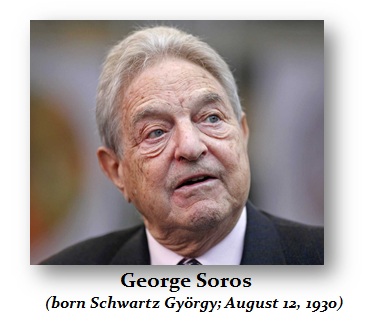 George Soros acknowledged in an interview with CNN that he actively contributed to the overthrow of former Ukrainian President Viktor Yanukovych in 2014. “I created a foundation in Ukraine before it became independent from Russia. The foundation has functioned since then and has played an important role in current events,” explains the financier who established the International Renaissance Foundation, in Ukraine, as part of the Open Society Foundations, in April 1990.
George Soros acknowledged in an interview with CNN that he actively contributed to the overthrow of former Ukrainian President Viktor Yanukovych in 2014. “I created a foundation in Ukraine before it became independent from Russia. The foundation has functioned since then and has played an important role in current events,” explains the financier who established the International Renaissance Foundation, in Ukraine, as part of the Open Society Foundations, in April 1990.
Yes, the CIA gained influence and picked who would take charge but they did not get the people to rise up — they did that on their own. They threatened the people and warned that if they overthrew the new hand-picked leaders that they would be on their own. You MUST draw a line between what the people did and what the West did afterward. These people who attribute everything to an all-powerful CIA plot have NO personal knowledge of anything and spin their opinion as to if it were fact. The whole “Fuck the EU!” comment by Victoria Nuland phoning with Geoffrey Pyatt was reported February 7th, 2014 and it only illustrates that there were efforts to gain control of the situation in Ukraine, but it does not demonstrate that the CIA organized the revolution from the start. Yanukovych fled Ukraine on February 22, 2014, just about 3 months from the beginning of the protests.
The puppet president of the West, Oleksandr Turchynov served as the acting president from February 23 until June 7, 2014, and was the only person in Ukrainian history to serve in the role. During his tenure, Turchynov was addressed as “acting president” by other Ukrainian politicians and the media.

This was followed by a questionable 2014 election which took place on May 25th, with businessman Petro Poroshenko claiming to have won just over 54% percent of the vote and was sworn in as president on June 7th, 2014. Poroshenko was a Ukrainian billionaire businessman known as the ‘Chocolate King’. However, our direct sources at the time in the East made it plain that they were unable to vote as the polling stations were destroyed by the pro-Russian terrorists/tourists. Those who would have voted in the East may have voted for Poroshenko because the general feeling was they needed a President who would have a majority vote with no run-offs to prevent civil war.
Poroshenko had promised to navigate between Russia and the West. But the fighting continued as the separatist rebellion in the Donets Basin continued. Poroshenko said at the time:
“The first steps of our entire team at the beginning of the presidency will concentrate on ending the war, ending the chaos, ending the disorder and bringing peace to Ukrainian soil, to a united, single Ukraine,” at a victory rally Sunday. “Our decisive actions will bring this result fairly quickly.”
Poroshenko has also said he wanted to lead Ukraine to closer ties with the European Union. During his speeches, Poroshenko on numerous occasions has called the war in East Ukraine a “Patriotic War”, yet did not initiate implementation of martial law. Nevertheless, the violence prevented many citizens in eastern Ukraine from voting.
Putin said a day before Ukraine voted that Russia would “cooperate with the authorities that will come to power as a result of the election,” but he added that he continued to consider Yanukovich the legitimate president of the country. Eventually, on June 18, 2015, Yanukovych was officially deprived of the title of President of Ukraine retroactively.
Poroshenko set up an offshore company in the British Virgin Islands to shelter his taxes from the sale of his company. Leaked documents from the Panama Papers from 2016 revealed that Poroshenko registered the company, Prime Asset Partners Ltd, on August 21st, 2014. He denied any wrongdoing and his legal firm, Avellum, overseeing the sale of Roshen, Poroshenko’s confectionery company, said that “any allegations of tax evasion are groundless”. The anti-corruption group Transparency International believes that the “creation of businesses while serving as president is a direct violation of the constitution”. His name was cited in the list of politicians named in “Paradise Papers” allegations.
This allegation against Poroshenko of tax evasion arose during the 2019 election which took place on March 31st, with a run-off on April 21st. As a result of this election, Volodymyr Zelensky, a former actor and comedian with no prior political experience, became the sixth President of Ukraine with 73% of the popular vote in the run-off against the incumbent Petro Poroshenko. Thus, Zelensky became President of Ukraine, serving since May 2019. Zelenskyy, who made his apparent fortune with a Ukrainian political satire that comedy television series was himself exposed to have been secretly financed by a friend of Soros, the Ukrainian oligarch Igor Kolomoisky. His name appeared in the revelations made thanks to the Pandora Papers investigation, the world’s largest-ever journalistic collaboration, involving more than 600 journalists. They uncovered the hidden owners of offshore companies, secret bank accounts, private jets, yachts, mansions, and precious artworks of a bunch of influential elite. More than 100 billionaires, 29,000 offshore accounts, 30 current, and former leaders, and 300 public officials were named in the first leaks in October 2021 that pushed many governments to launch their own inquiries into the financial activities revealed in the papers.
Nevertheless, within months of the election, on December 20th, 2019, Ukrainian law enforcement raided both Poroshenko’s party headquarters and gym on the orders of President Zelensky to eliminate any possible influence of Poroshenko going forward. Zelensky outright accused Poroshenko of state treason, aiding terrorist organizations, and financing terrorism due to allegedly organizing the purchase of coal from separatist-controlled areas of Ukraine together with pro-Russian politician Viktor Medvedchuk. Poroshenko denied the allegations, calling them “fabricated, politically motivated, and black PR directed against [Zelensky’s] political opponents”.
The worldwide probe by the International Consortium of Investigative Journalists (ICIJ), which included journalists from the Ukrainian media Slidstvо.Info, which connected the questionable backing of Zelensky’s television production company Studio Kvartal 95 to the Soros connected Ukrainian oligarch Igor Kolomoisky. Slidstvo found that the laundered money passed through the Cyprus branch of Kolomoisky-owned Privatbank, according to law enforcement officers. This has raised deep concerns about Zelensky’s links to not just George Soros but to Klaus Schwab’s World Economic Forum. This has led to many Ukrainians viewing the old saying, the King is dead, long live the King – meaning they traded one corrupt politician for another.









